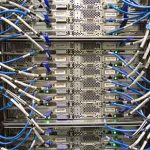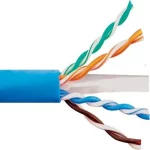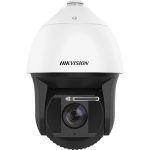Cable management in an IT rack is important for maintaining the organization, functionality, and aesthetics of the rack. Here are some best practices for cable management in IT racks when doing Data Cabling:
- Label all cables: Labeling all cables with their corresponding device or port can make it easier to trace and troubleshoot issues in the future.
- Group cables together: Grouping cables by type or function (i.e. power cables, network cables, etc.) can make it easier to identify and organize them.
- Use cable ties: Cable ties or Velcro straps can be used to bundle and secure cables together, reducing clutter and maintaining a neat appearance.
- Route cables properly: Cables should be routed in a way that allows for proper airflow and prevents them from getting tangled or blocked. This can be achieved by routing cables through cable management trays or troughs.
Routing cables in an IT rack properly is important for maintaining the organization, functionality, and aesthetics of the rack. Here are some best practices for routing cables in an IT rack:
- Plan ahead: Before installing new equipment or adding new cables, plan out the best routing path for the cables to minimize clutter and ensure proper airflow.
- Use cable management trays or troughs: Cable management trays or troughs are designed to guide and organize cables, keeping them neat and tidy.
- Route cables in a logical order: Cables should be routed in a logical order, such as grouping power cables together and network cables together.
- Keep cables away from heat sources: Cables should be kept away from heat sources, such as power supplies and fans, to prevent damage and reduce the risk of fire.
- Avoid sharp bends: Cables should be routed in a way that avoids sharp bends, which can damage the cables and impede signal quality.
- Keep cables organized at the patch panel: The patch panel is where all the cables in the rack connect. It is crucial to keep cables organized and labeled at the patch panel to avoid confusion and ensure proper connectivity.
- Regularly review and maintain: Regularly reviewing and maintaining the cable routing in the rack will help to keep the cables organized and easy to identify.
- Use cable guides: Cable guides can be used to direct cables and maintain a clean and organized appearance.
- Keep cables organized at the patch panel: The patch panel is where all the cables in the rack connect. It is crucial to keep cables organized and labeled at the patch panel to avoid confusion and ensure proper connectivity.
- Avoid overloading the rack: Overloading the rack with too many cables can lead to clutter and impede airflow, which can affect the performance of the equipment.
- Regularly review and maintain: Regularly review and maintain the cable management in the rack will help to keep the cables organized and easy to identify.
Why use Velcro to tie cables?
Velcro is often used in cable management as a convenient and effective way to bundle and secure cables together. There are several reasons why Velcro is a popular choice for cable management:
- Reusable: Velcro can be opened and closed multiple times, making it easy to add or remove cables as needed.
- Adjustable: Velcro straps can be adjusted to fit the size of the bundle of cables, providing a secure and snug fit.
- Easy to use: Velcro is easy to apply and remove, making it a simple solution for cable management.
- Durable: Velcro is a strong and durable material that can withstand the wear and tear of regular use.
- Cost-effective: Velcro is relatively inexpensive and widely available, making it a cost-effective solution for cable management.
- Customizable: Velcro straps come in different widths and lengths, making it easy to find the perfect fit for a wide variety of cables.
- Non-damaging: Velcro straps do not damage the cables, unlike other options like cable ties, which can damage the cable’s insulation.
- Versatile: Velcro can be used in a variety of settings, including server rooms, data centers, and home offices.
By following these best practices, you can ensure that your IT rack is well-organized, easy to manage and troubleshoot, and that the airflow is not impeded by the cables, which can affect the performance of the equipment.




